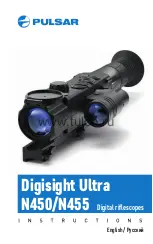
10
A telescope is an instrument that collects and focuses light. The nature of the optical design determines how
the light is focused. The refractor telescope uses lenses in its optical design.
Developed in the early 1600s, the refractor is the oldest telescope design. It derives its name from the
method it uses to focus incoming light rays. The refractor uses a lens to bend or refract incoming light rays,
hence the name (see Figure 3-1). Early designs used single element lenses. However, the single lens acts
like a prism and breaks light down into the colors of the rainbow, a phenomenon known as chromatic
aberration. To get around this problem, a two-element lens, known as an achromat, was introduced. Each
element has a different index of refraction allowing two different wavelengths of light to be focused at the
same point. Most two-element lenses, usually made of crown and flint glasses, are corrected for red and
green light. Blue light may still be focused at a slightly different point.
F
F
o
o
c
c
u
u
s
s
i
i
n
n
g
g
For the 80mm Ambassador, simply turn the focus knob (located in front of the diagonal – see Figure 3-2).
Turning the knob clockwise allows you to focus on an object that is farther than the one you are currently
observing. Turning the knob counterclockwise from you allows you to focus on an object closer than the one
you are currently observing.
For the 50mm Ambassador, simply turn the large knurled ring shown in Figure 3-3. Turning the focus ring
counterclockwise allows you to focus on an object that is closer than the one you are currently observing.
Turning the focus ring clockwise allows you to focus on an object farther than the one you are currently
observing. Remember to remove the front objective cap prior to observing through the telescope.
Note:
If you wear corrective lenses (specifically glasses), you may want to remove them when observing
with the telescope. If you have astigmatism, corrective lenses must be worn at all times.
Figure 3-2
Figure 3-3
Figure 3-1
A cutaway view of the light path of the Refractor optical design


























